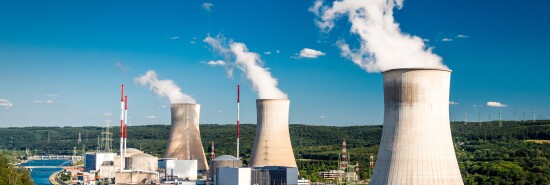
Nuclear power is key to cleaner, affordable, and safer energy
Grant Dever
Video Embed
Governments and people throughout the world are seeking access to additional, affordable energy. Countries throughout Europe have now abandoned their plans to shutter coal-fired energy plants as they work to mitigate the risk of rolling blackouts. Cooler weather is on the horizon and Europeans are concerned they won’t be able to keep the heat on this winter. This shock, exacerbated by Russia’s invasion of Ukraine, is set to delay Western countries’ plans to decarbonize their energy sectors by years.
In order to prevent future crises and reach their decarbonization goals, European countries and the U.S. should consider building new nuclear reactors. Nuclear power is safe, reliable, and low-carbon. The federal government has recently affirmed its support for nuclear power in the Inflation Reduction Act by allocating subsidies to encourage the building of new plants. Unfortunately, however, Congress did not reduce regulatory barriers for doing so.
Even before this most recent shock, the U.S. grappled with volatile energy prices and unreliable grids, particularly in states like Texas and California. Rising energy prices have devastated lower and middle income family budgets abroad and throughout America. The costs of most of the necessities of life — home electricity, food, and heat — all fluctuate with the price of energy.
Anti-nuclear activists argue that the U.S. can transition from fossil fuels to an energy mix of mostly solar, wind, and hydro with batteries as emergency backup. They’re wrong. The reality is that battery technology is expensive. Energy storage requirements rise unsustainably as a greater proportion of the energy mix comes from intermittent sources such as wind and solar. Put simply, if a greater portion of a grid’s energy mix comes from solar, the grid will need many more batteries to maintain reliability during a stormy week or forest fire season. To maintain reliability and affordability, policymakers will need to ensure that the baseload power from decommissioned coal plants is replaced by another source that’s independent of weather conditions.
Ontario, Canada and France have successfully reduced dependency on coal plants through investment in nuclear power. Their actions exemplify how to safely and affordably transition to nuclear power. Seventy percent of France’s electricity and 58% of Ontario’s energy come from nuclear power. Canada’s household electricity prices are lower than those in the U.S., and France provides far cheaper electricity than many countries in Europe, including Germany, which aggressively pursued wind and solar while closing its nuclear plants.
France and Canada have managed to significantly reduce their carbon emissions without the severe reliability issues that accompany wind and solar production. To the extent that the French have had issues, they have largely been due to arbitrary decisions to decommission nuclear plants and a corresponding lack of investment in maintenance. Now the French government intends to streamline its own regulatory processes and build six new reactors.
In my recent paper for the Foundation for Research on Equal Opportunity, I analyzed how the U.S. would have reduced its carbon footprint if its electricity mix had developed in a similar way to France’s from 1979 to 2020. Coal’s share of the French electricity mix peaked in 1979, as their government pursued an aggressive nuclear energy policy to reduce their dependence on other countries. France built 59 new reactors between 1971 and 1991, displacing their coal plants and other less efficient energy producers. If the U.S. had continued its investment in nuclear power from 1979 to 2020, 33,605 terawatt hours of electricity would have been generated by American coal plants instead of 66,359 terawatt hours. This would have resulted in 24.4 fewer gigatons of carbon emissions, a reduction of 45% of emissions from coal produced electricity. To put that number in perspective, the U.S. generated 4.6 gigatons of carbon emissions in all of 2020.
The U.S. civilian nuclear power sector has one of the best safety records of any industry. There have been zero deaths resulting from exposure to radioactive materials. Every nuclear meltdown across the globe spurred better designs and processes here and elsewhere. Tragically, ten nuclear workers have been killed in workplace accidents since the opening of the Shippingport Atomic Power Station in 1958. In comparison, though, there were 11 coal mining deaths and 22 oil and gas extraction deaths in 2019 alone. The heightened fears around nuclear energy are understandable given the memories of the Chernobyl disaster in 1986, but nuclear energy production is far safer for workers and the general public than our traditional energy sources.
The Biden administration and our current Congress both believe that nuclear power is key to making a successful clean energy transition. The inclusion of funding for existing and new advanced nuclear reactors in the recent Inflation Reduction Act has affirmed their commitment. Now Congress should pursue direct reform of the Nuclear Regulatory Commission’s policies to remove excessive red tape that inhibits investment and the expansion of the American civilian nuclear industry. Reforming nuclear regulations to build new plants is necessary for American policymakers to build a future where energy is affordable, reliable, safe, and low carbon.
Grant Dever is a visiting fellow at the Foundation for Research on Equal Opportunity.
